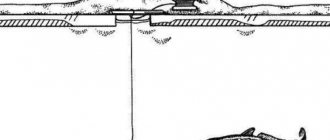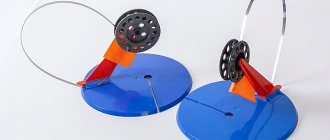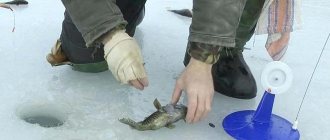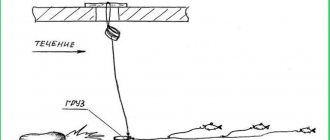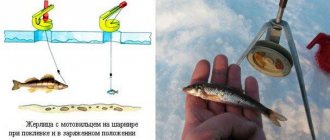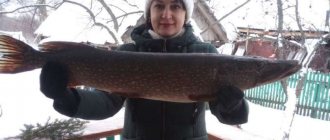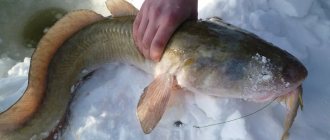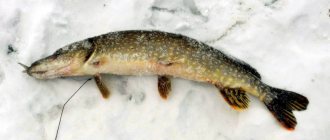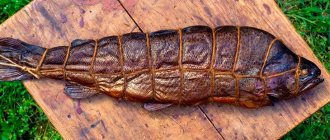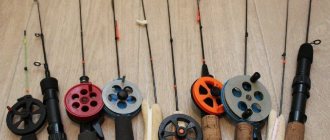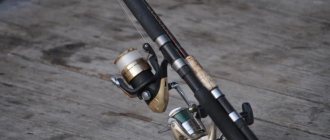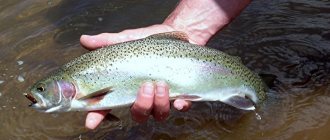Pros and cons of fishing
Fishing for rainbow trout on girders has the following advantages:
- ease of fishing;
- no need to purchase expensive artificial baits;
- the opportunity to catch quite a lot of fish;
- paid reservoirs have an established recreation infrastructure.
Fishing for iris on paid sites has the following disadvantages:
- restriction on the number of girders, which exists on most paysites;
- the difficulty of determining the horizon on which the fish is holding;
- the need to fine-tune the rigs, since the trout spits out the bait if it doesn’t like something.
Main features of fishing
For many anglers, the opportunity to catch trout is a real drug , because it is enough to take part in a fight with such a predator once in your life and in the future it will be impossible to refuse such happiness. Due to the phenomenal activity that continues throughout the year, the fish bite excellently even in winter, which increases the number of adventurers. Trout is considered a very interesting fishing object, which has many advantages:
- Almost always large specimens weighing 5 kilograms or more are caught on the hook.
- The fishing process lasts a long time, making the fisherman experience an unforgettable sensation.
- Trout meat is a real culinary delicacy that simply has no competitors.
Anglers who know how to catch trout on a platform in winter (a private reservoir) claim that in most cases they come across individuals weighing from 1.5 kg, reaching 50-70 centimeters in length. In larger bodies of water or in natural wild conditions, these figures exceed 6 kilograms with a length of 70 centimeters. Therefore, the capture of large trophy prey is not uncommon.
Places for fishing on paid platforms
Trout can be found anywhere in a body of water. During the deep winter period, aerators are installed on some pay zones to enrich the water with oxygen, since this fish is very sensitive to the oxygen content in the water. Fishing near aerators is more promising, although it is believed that fish living away from these devices are more active. If the bottom of the reservoir has a pronounced relief, then knowing its features, you can optimize the fishing process.
The difficulty lies in determining the horizon on which the iris rests. If, when fishing with artificial bait, the angler has the opportunity to consistently fish all layers of water, then the bait on a permanently installed girder may end up outside the trout’s habitat.
Typically, trout do not stay near the bottom, but in half-water, but with a large depth of the reservoir, determining the desired horizon is not easy. Therefore, as a rule, fishermen combine fishing with active gear with fishing with girders and baitfish. Using artificial bait, they determine the horizon that is promising for fishing and release the girders to the required depth.
Promising places to find fish
Currently, paid reservoirs and private trout farms exist in almost every city or nearby. Therefore, in literally an hour's drive you can find yourself in an amazing corner and spend time usefully and happily doing your favorite activity . And although a good bite in such conditions is practically guaranteed, you cannot do without knowing the important subtleties.
Particular attention should be paid to choosing the place where fishing will take place. In this case, it is necessary to at least know how many years ago the fish were released into the pond, because adult individuals prefer to stay in their favorite places, from where it is almost impossible to scare them away, with the exception of dangerous circumstances in the form of loud talking, stomping or careless behavior.
If young animals have recently been released into the reservoir, then most likely they will not stand still. This fish leads an active lifestyle and intensively studies the water area. Here it is advisable to use the “intercept” fishing method, having previously studied the trout routes.
There is an opinion that in most cases the predator moves along the edges, but if you do not know the features of the bottom topography, then you need to be guided by the following options for determining a promising route:
- You can calculate the exact location of the fish on your own, starting by drilling holes near the shore, and then going deeper to the middle of the reservoir. If you find a sharp change in depth, it means there is an edge there. It is recommended to start fishing in a place where there is a decline in relief.
- You can also check the necessary information with a security guard or huntsman. Such people know where there are concentrations of rainbow trout and where they are practically absent. Therefore, communication with them always gives good results.
- Chat with other anglers who have been fishing on this body of water for a long time. As a rule, trout seekers set up ambushes near promising spots, so just join them.
- You can try to find old, frozen holes. In this case, it’s easy to guess that fish have already been caught there and the bite will be stable.
It is important to note that trout are caught at different depths, because sometimes they react to the bait directly at the bottom, but then rise to the surface of the water and try to find food there. If activity has decreased, try changing the fishing depth. The lack of a bite after such actions is a reason to change place.
Varieties
As already mentioned, trout, unlike pike, spits out the bait at the slightest suspicion, so the line should come off the line so that the fish does not feel resistance. In this regard, in addition to the classic girders on the platform, other designs are used, namely:
- stand on a stand.

The basis of such equipment is a fishing rod, which can be used to catch trout in an active way. The fishing rod is fixed on a special stand. Such gear needs to be monitored, and as soon as the end of the rod goes down, you need to hook;
- shifter.
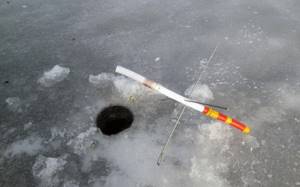
This kind of gear is easy to make yourself. The zherlitsa reacts sensitively to bites, and the line comes off very easily, so there may be cases of fish hooking themselves;
- at American girl The spool is located under water, so the line comes off very easily.
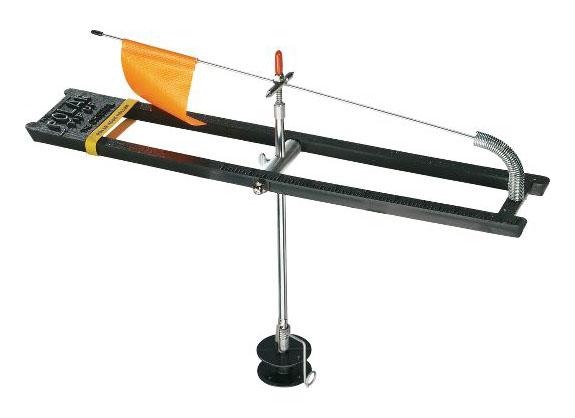
But such gear has not caught on here, firstly, due to its high cost, secondly, because of the complexity of the design, which greatly complicates the installation process, and thirdly, because of the inconvenience of use at low temperatures.
Device
Most often, fishermen use classic girders with a platform and a signaling flag, because they are easy to buy, they are inexpensive, and installation is simple. The vent itself and its equipment includes:
- Base. The base or platform is made of plastic and has a round shape. A stand with a reel and a bite alarm with a flag are attached to the platform. A radial slot is made in the base to allow fishing line to pass through.
- Coil. The coil is located on the stand and is attached to it using a bracket. The coil requires:
- so that it rotates easily;
- to have the largest possible diameter.
- Bite alarm - flag. The bite alarm is made from a clock spring. At its end there is a flag made of waterproof red fabric.
- Fishing line. Monofilament with a diameter of 0.3-0.35 mm is used as the main line for catching iris. At least 10 meters of fishing line is wound onto the reel.
- Sinker. A sliding “olive” of the minimum possible weight is used as a sinker.
- Leash. A leash 50 cm long is made of fluorocarbon with a diameter of 0.2-0.3 mm. Its thickness depends on the size of the intended prey.
- Hook. The hooks used are single hooks made of thick wire, size No. 6-No. 2 according to the international classification.
Expert opinion
Knipovich Nikolai Mikhailovich
Zoologist, hydrobiologist. I am interested in fishing at a professional level.
Healthy! Some anglers paint half the reel in some color that contrasts with the main background. This makes it possible to see from afar how the reel unwinds.
How to make it yourself
Most often, classic type vents are made. They are wind-resistant and protect the hole from freezing, although their compactness when assembled leaves much to be desired. You can make such a girder as follows:
- Using a hacksaw to cut out a platform from plywood or foam plastic. It doesn't have to be round.
- A slot is made in the platform for the fishing line.
- A stand is made from a metal corner or tube and secured to the platform with screws or rivets.
- A bracket is made from a bicycle spoke.
- The reel is mounted on a bracket to the stand.
- The reel is made from an empty fishing line spool.
- A bite alarm is made from elastic wire or a clock spring.
- A flag made of red fabric is glued to its end.
- Wind the line onto the reel.
- Place a sinker on the line.
- Attach a swivel with a clasp to the free end of the fishing line.
- A leash is made by tying a hook to it with a clinch knot.
- Attach the leash to the main fishing line.
Expert opinion
Knipovich Nikolai Mikhailovich
Zoologist, hydrobiologist. I am interested in fishing at a professional level.
Attention! The vent must be collapsible. It is advisable to store all its parts, namely: a platform, a stand with a reel, a bite alarm, a leash, in separate bags.
Float rod
Float tackle is less popular when fishing for winter trout, but anglers also use it to catch spotted beauties. The main disadvantage of the float is that when the water in the hole freezes, this affects the buoyancy of the float and only sharp bites are visible. In clear water, trout take the bait carefully and the freezing float does not always show these “poke” of the fish.
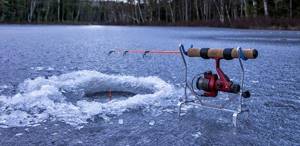
The fisherman has to constantly monitor the condition of the hole and clean it of sludge. Another nuance is related to the fact that trout take moving baits better than static ones, and when using a float you have to “play” with the bait, attracting the attention of the fish. To do this, every couple of minutes the equipment is raised by 20–40 centimeters and lowered into the hole.
Float and weight
A winter float fishing rod for trout is in many ways similar to a nodding rod, but instead of a nod, the bite signal is a float. The float is selected according to the weight of the equipment, and the olive acts as a load.
The antenna of the float, 5–7 cm long, is slightly recessed and protrudes 2–3 cm above the water surface. A regular float for summer fishing with a dark-colored lower part is suitable. The tackle must be in a tense position, and the main role in this is given to the weight.
In order to straighten the fishing line as much as possible, several small weights are used, at a distance of 5-10 cm from each other. Their total mass should balance the selected float.
Important! The hook with the nozzle should be at a distance of 10–30 cm above the bottom level, and the height of the float regulates this distance.
Fishing lines
A reserve of fishing line is left on the reel in case of a sharp bite and landing of heavy fish. The diameter of the main line is 0.2-0.22 mm, the color is the least noticeable in this body of water. The length of the leash for a float rod is 30–50 cm, and the diameter of the leash line is 014–0.16 mm.
Some fishermen, in order to make the tackle minimally noticeable, take 0.12 and even 0.10 mm fishing line for leashes, but this is fraught with breaks when fishing and hooking a trophy. Arriving at a reservoir, you need to find out what the approximate weight of the main mass of trout is and, based on this, choose a leading line. The tackle should be sensitive, but strong enough to hold the fish that bites and pull it out of the hole.
Hooks
The size of the hook for catching trout on a float rod is selected depending on the dimensions of the baits used. In this case, the hooks must be strong and very sharp so that they pierce the fish’s lip. Hook number 10–16 according to the European classification.
Choose hooks designed for float fishing with a straight shank and a long blade. Bright colors of hooks repel winter trout, this is also taken into account. Don’t skimp on hooks when fishing for trout; the fish actively resists when you fish it out and, due to blunt hooks, offensive catches can happen.
Float tackle design
When fishing for trout with a float, two main types of equipment with one or more leashes are used. A single leash is more convenient because it does not cling to obstacles in the water column while landing fish. If you are sure that the bottom is clean, use a rig with 2-3 leads, which will increase the chances of catching fish.
With one hook
To install a fishing rod with one leash and hook you will need:
- float stops;
- float;
- weights for the weight of the float;
- swivel with clasp;
- regular swivel;
- leash with hook.
The process of making a float rod for trout fishing with one hook:
- We put a stopper on the main line and pull it up.
- We put on a swivel with a clasp to secure the float.
- We attach the float.
- We tie the swivel.
- Above the swivel, at a distance of 3–5 cm, we attach weights according to the weight of the float.
- We tie a leash to the swivel.
Using the stopper, the depth of immersion of the equipment in the water is adjusted; when the depth increases, the stopper rises up, and when it decreases, it drops lower. The float moves freely along the line, since the swivel to which it is attached is sliding.
After drilling the hole, the stopper rises up and the tackle is immersed in the water, while the float lies on the water. Lowering the stops below, we are looking for a length at which the float will float in working condition and even be slightly submerged. This means that the tackle is completely straightened in the water and at the slightest touch of the fish to the hook with the nozzle, the float will signal this. If necessary, the immersion height of the tackle is adjusted using the upper stopper. The rig is very sensitive and knits quickly.
Important! The float should be slightly recessed, and if it is hard to see, install another one with a longer antenna. If the float just floats, it will be much more difficult to see the bite, which means the catch will be smaller.
With multiple leashes
To make a rig with 2-3 hooks, you will need:
- float stop;
- swivel with clasp;
- float;
- a weight with an eye according to the weight of the float;
- leashes with hooks.
Knitting order:
- We put a float stopper on the main line.
- We attach the swivel to the clasp.
- We attach the float to the swivel.
- We tie a weight to the end of the fishing line.
- Starting from the load, we tie leashes at a distance of 7–10 cm from each other.
It turns out that after putting the equipment into the water, the weight will pull it down and it remains to set the depth so that the weight is at a distance of 3-5 cm from the bottom. The length of the leashes is 15–20 cm, so the lower leash will be on the bottom, and the upper ones will be located in the water column.
Such a fishing rod fishes the bottom layer with a height equal to the distance from the bottom to the upper leash, which increases the chances of catching fish. To prevent the leashes from getting tangled, they are knitted from fluorocarbon, especially since this material is invisible in water. A fishing rod of this design performs well when fishing in holes and exits from holes, and fish love such places.
But during the thaw, the fish comes out of its hiding place and it is better to catch it in shallow water, with a fishing rod with one hook. Due to the fact that the float is attached to a swivel with a clasp, if necessary, it is easy to replace it with a more sensitive one, or with a longer antenna. That is, the tackle is convenient for experiments and its fine tuning takes 3–5 minutes. When fishing from ice, this is very important, because your hands get cold and the water in the hole freezes.
How to install correctly
Correct installation of the vent is carried out as follows:
- They drill a hole.
- They clear it of sludge.
- Measure the depth, preferably using a special depth gauge.
- Assembling the girder.
- The required amount of fishing line is measured, which, in the opinion of the fisherman, will be optimal for catching trout.
- The fishing line is fixed on the reel with a bite alarm.
- They set the bait.
- Lower the equipment into the hole.
- Lightly sprinkle the hole with snow.
- Place the vent on the hole.
Trout fishing tactics and techniques
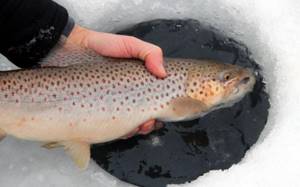
In our country, owners of paid fishing grounds allow fishing with a small number of gear, including active fishing gear, while abroad you can often use only one gear. Therefore, the girders must be arranged rationally. Trout constantly moves around the reservoir and you can catch it almost anywhere. If possible, you need to focus on other anglers.
Iris can be caught in two ways:
- put out the zherlits and go to show off;
- Constantly watch the girders.
With the second fishing method, the chances of catching an iris on a girder are small, since it rarely catches itself. But you can catch fish with artificial bait, which is much more interesting.
The tactics for catching trout on girders is to constantly rearrange the gear and change the depth of release. It is also necessary to try different baits, since the food preferences of the iris are unpredictable.
Expert opinion
Knipovich Nikolai Mikhailovich
Zoologist, hydrobiologist. I am interested in fishing at a professional level.
Important! How to behave when bitten? You should not expect that the trout will take the bait in its mouth, taste it, and then, having swallowed it, begin to move away, as the pike does. As soon as the iris winds 30-40 centimeters of fishing line, you should cut sharply.
Fishing for prey should be done carefully, without forcing the process, but also without giving in to slack. Trout have fleshy lips, and the hook, as a rule, is held firmly in them, but a strong fish can break the line, and if there are snags on the bottom, then it will most likely rush into them and it will be extremely difficult to get it out.
Those who are used to catching perch, pike perch and pike have no idea how strong rainbow trout are. Therefore, the hook should always be at hand, and a hole with a diameter of 130 mm may be too small to easily bring prey into it. In addition, fish of different sizes often live in the same body of water, and among the pre-kilo fish there may be “five”, for which the fisherman must be prepared – both morally and technically.
Best time to go fishing
Before you start fishing, you need to find out the best time to start fishing, based on the preferences of the fish, time of day and weather conditions.
It is known that trout are excellently caught with a winter fishing rod immediately after the ice freezes, but there is no need to rush to the reservoir on the very first day. Instead, you need to wait until the ice is completely strong and fishing is safe. Only after this can you prepare your gear and safely run to your favorite activity. Trout can be caught from early morning until dusk. According to experienced fishermen, the most intense bite occurs during daylight hours, and at night it subsides. However, until 10 a.m. the trout stays in one place, but then begins to move throughout the entire reservoir.
The inhabitant of paid reservoirs, which bites excellently in winter, is called rainbow. It was brought to us from America, where it was populated specifically for winter fishing, long before this type of activity appeared in the domestic space.
